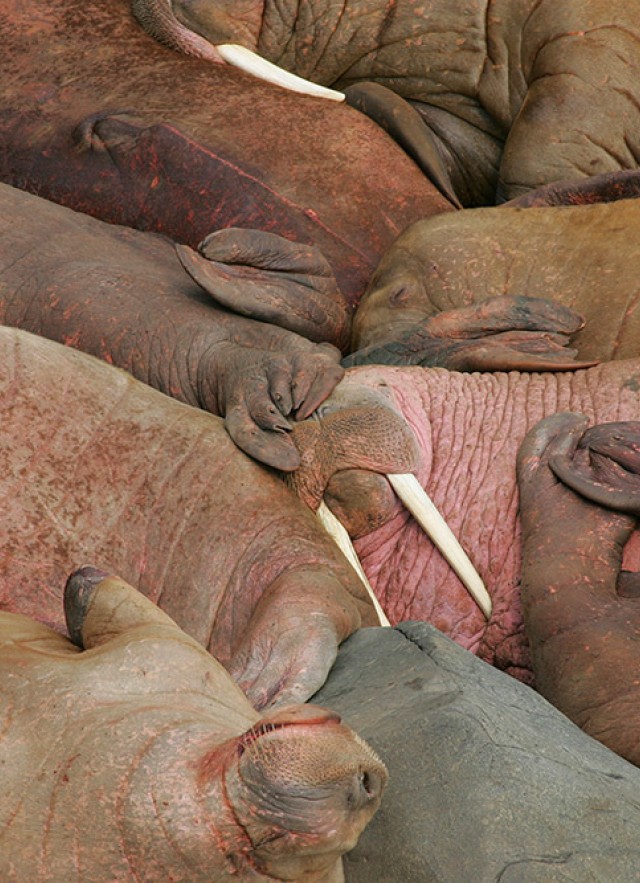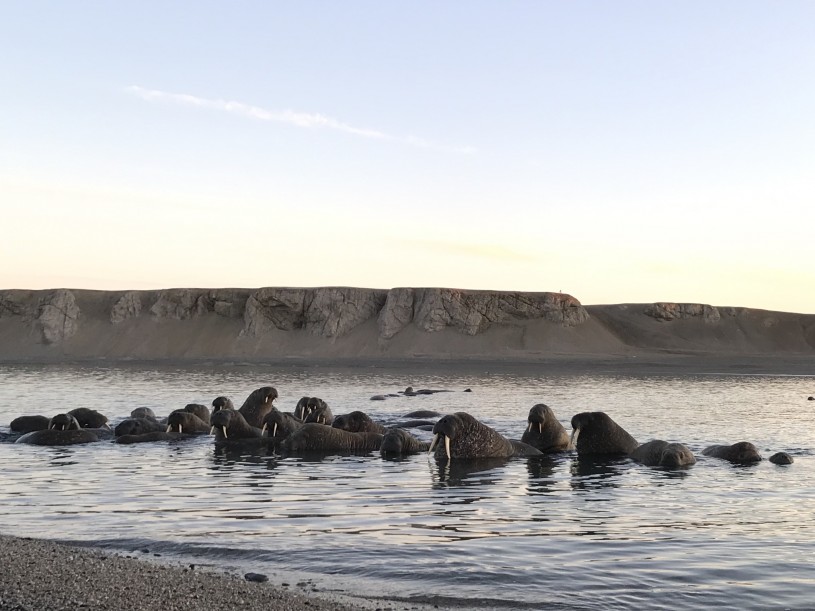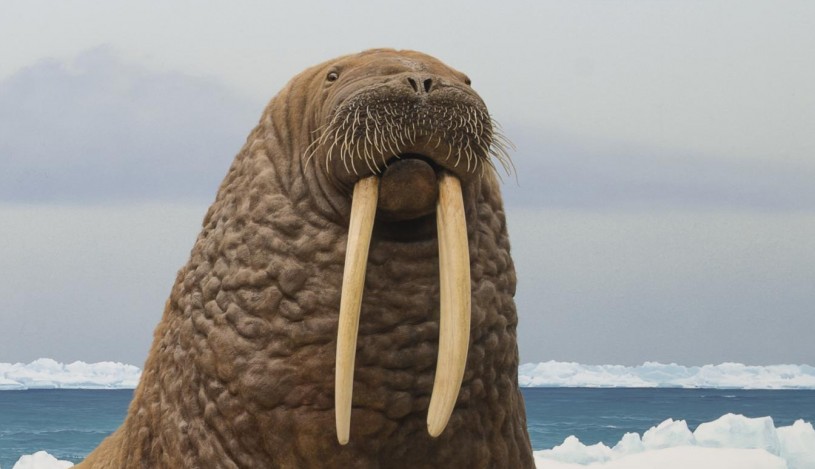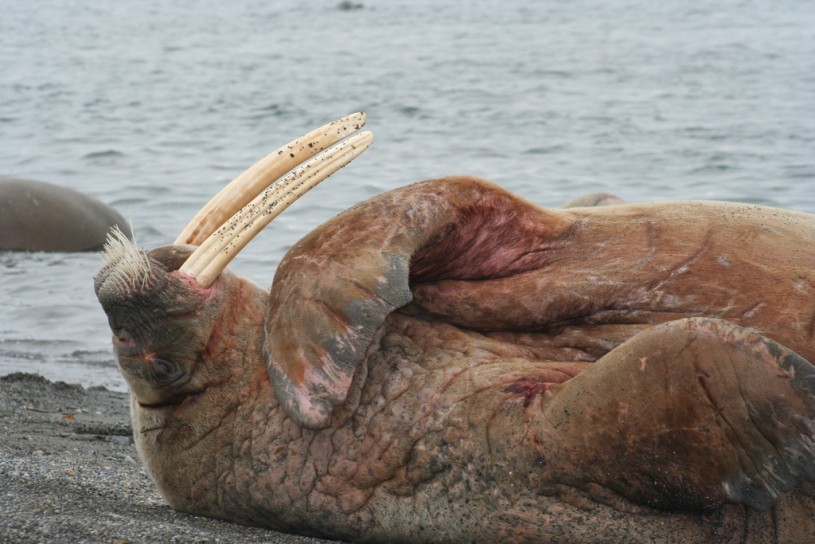Walruses: On the Tusk of Greatness
With the discovery of the oldest tusked walrus yet, NHM scientists are getting to the root of the walrus’ long tooth.

Above photo: Walruses relaxing Togiak, Alaska, © iNaturalist user Stephen_WV
Draw a picture of a walrus in your mind’s eye, and it’ll go something like this: a roly-poly body thick with blubbery insulation, a distinguished mustache and invariably, a pair of long white tusks. In our collective imagination, tusks are their defining feature. Even the meaning of their Latin name, their binomial nomenclature, Odobenus rosmarus translates to ‘tooth-walking sea horse’, thought to be a reference to pulling themselves onto solid ice with their tusks like nature’s own ski poles.
Like the rest of life on earth, the walrus we know and love is the result of the push and pull of natural selection, a reflection of momentous changes in the environment over the 17 million years that walruses have been on the planet. All of which is to say, they didn’t always have tusks. So when and how did walruses acquire their most iconic feature? In a new paper, NHM’s Associate Curator of Marine Mammals Jorge Velez-Juarbe and his colleagues report on, among other things, Osodobenus eodon, the oldest tusked walrus yet found in the fossil record, expanding our understanding of those famous pearly whites along the way.

Ancient WalrusES swam in Different waters
“Osodobenus was living in a much warmer environment than its modern contemporaries.” says Velez-Juarbe. While today’s walruses stick to the frigid waters of the arctic and subarctic, extinct odobenids (the family of marine mammals survived only by our modern walrus) once swam in very different waters, and their fossils have been found everywhere from Mexico to Japan. Osodobenus eodon was more of a local: the fossils were discovered in Orange County’s Capistrano Formation, not far from Dana Point. Our local waters looked much different 5–10 million years ago, and Osodobenus would have had plenty of strange company. “In addition, there were other species of walruses, sea lions and fur seals living in the same habitats along the Southern California coast. Other animals which shared the local sea with Osodobenus included a variety of sharks, marlins, saber-toothed salmons, leatherback turtles, crocodiles and a wide variety of whales, dolphins and porpoises.” Tusks must have helped Osodobenus get the calories needed to compete in these ancient, crowded waters.
Like today’s walrus, Osodobenus was likely a benthic suction feeder: Picture a walrus doing its best impersonation of a vacuum cleaner, hoovering up small animals off or close to the seafloor. While the exact diet of these animals remains a mystery, anatomical features guide our understanding of how they fed. “Some of the specializations related to benthic suction feeding we see in Osodobenus includes having a highly arched palate, which we usually see in suction feeders as the greater surface area helps create a vacuum inside the mouth to suck in their prey.” says Velez-Juarbe.

Along with tusks, Osodobenus likely shared a familiar facial hair with modern walruses. “O. eodon has large infraorbital foramina (an opening in the skull below the eyes), which is indicative of the presence of a large infraorbital nerve, which is the main sensory connection going to the whiskers.” says Velez-Juarbe. “In other words, Osodobenus likely had a mustachioed appearance as do living walruses, which is definitely an advantage if you're looking for food on the seafloor.” Their whiskers would’ve helped suss out what exactly they were about to suck up. Mustaches for walruses never go out of style.

Getting to the root of TUsks
Tusks are the key feature of modern walruses, helping the animals do everything from ‘tooth walking’ to punching air holes in sheets of ice. Walrus tusks are technically just really big canines, but what separates the regal tusk from just a big tooth? “To us (Jake, Jim and I) one of the most striking characteristics of Osodobenus was that it had very large canines, large enough for us to consider them as tusks.” Velez-Juarbe said. But pushback from scientists reviewing their paper led Velez-Juarbe and company to develop a framework that finally gets to the root of what makes a tusk in walruses. “It turns out that there wasn't a clear definition, with some species with large canines variably considered as having or not having tusks.” Some extinct walrus species don’t have tusks, and some do; Osodobenus had canines bigger than its tuskless cousins, but smaller than tusked relatives. In their paper, Velez-Juarbe and company lay out that one key feature is “a root that is open proximally”, meaning that the canines, on top of being proportionally larger, would likely be capable of continuous growth.

It’s the potential for continuous growth that makes a tusk a tusk, and these discoveries mark continuous growth in NHM’s collection of walruses along with huge potential. While finding the oldest tusked walrus and developing a framework for identifying tusks are super cool, the paper also describes two other new species of extinct walruses, expanding our understanding of these animals and making NHM the go to hub for studying walrus evolution. “With the description of these three new species, our museum now has a total of six holotypes of extinct walruses (more than any other museum in the world), in addition we have other specimens and research casts representing more than half of the known species of walruses. Holotypes are the name-bearing, reference specimens that researchers usually need to examine in order to compare with new material they may be working on, which makes NHMLAC an obligatory stop for anyone studying the evolutionary history of walruses.”
Read the whole article in the Journal of Vertebrate Paleontology here and stay tuned for the newest discoveries on ancient marine mammals.